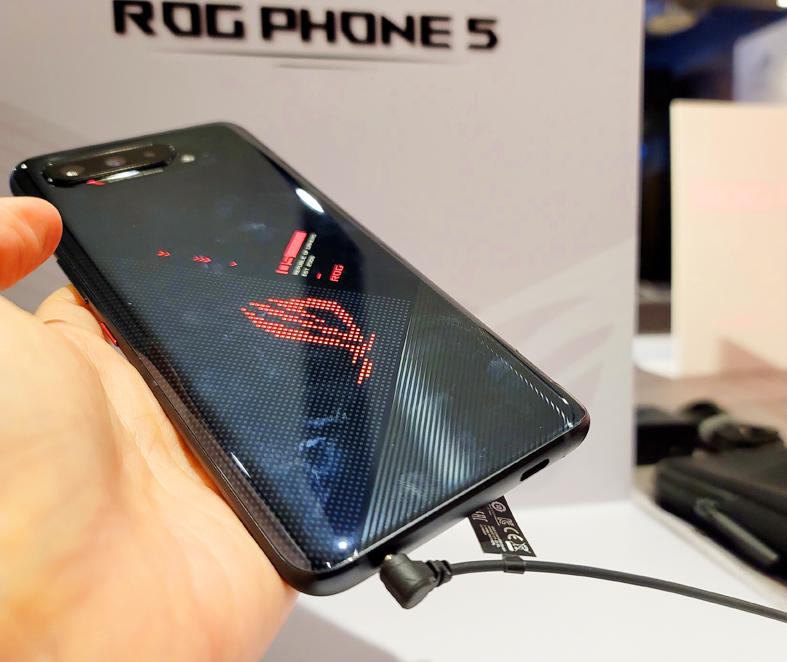Asustek Computer Inc (華碩) has launched the latest in its Republic of Gamers (ROG) smartphone line targeting Android gamers in markets like China.
The ROG Phone 5 maintains the heritage of over-the-top specs and design: Its exterior is decorated with angular motifs and its interior is populated with up to 18GB of memory and Qualcomm Inc’s latest Snapdragon 888 processor.
It has a custom-made 6.8-inch Samsung OLED display, contains two battery cells and is cooled by a vapor chamber system — and its higher-tier models bundle an attachable fan cooler for even more performance.

Photo: Wu Pei-hua, Taipei Times
In the commodified Android device market, Asustek is betting on its brand association with gaming and the broad enthusiasm for a tailored user experience.
The ROG Phone 5 comes with an app providing a console-like interface and the company is working with game makers to add support for the highest refresh rates its display is capable of.
However, to break past its 0.2 percent global market share, the company would need some help, Neil Mawston of Strategy Analytics said.
“Fancy smartphone features are only one leg of a three-leg stool. A top global smartphone vendor today also needs a loud mobile brand plus extensive retail presence — two things that Asus lacks right now,” Mawston said.
Asustek has found success partnering with Chinese Internet giant Tencent Holdings Ltd (騰訊).
The two companies have collaborated on the marketing of ROG phones and certification of games in China for several generations, and the country is one of Asustek’s main focus markets, the company said.
Unlike the PC market, where higher clock speeds and more memory can translate into being able to play at higher fidelity or on larger screens, in the mobile realm practically every company relies on the same basic architecture.
The leading duo of Apple Inc and Samsung Electronics Co consistently tout their devices’ gaming capabilities, pushing brands like Asustek to focus on hardcore gaming fans.
“For these branded gaming phones to grow, vendors will need to heavily invest in e-sports tournaments and have their phones become the official competition phone so that demand can flow from top to bottom,” International Data Corp analyst Liao Yexi said.
“Gaming performance is their top-selling point and hence the target audience has to be both hardcore gamers and professional gamers,” Liao said.
Asustek has seen “big growth” in sales between each successive ROG Phone generation, the company said, and it appears committed to the niche it has carved out.
The ROG Phone 5 starts at 799 euros (US$950) and scales up to 1,299 euros for an Ultimate fan edition with maxed-out memory and storage.

The demise of the coal industry left the US’ Appalachian region in tatters, with lost jobs, spoiled water and countless kilometers of abandoned underground mines. Now entrepreneurs are eyeing the rural region with ambitious visions to rebuild its economy by converting old mines into solar power systems and data centers that could help fuel the increasing power demands of the artificial intelligence (AI) boom. One such project is underway by a non-profit team calling itself Energy DELTA (Discovery, Education, Learning and Technology Accelerator) Lab, which is looking to develop energy sources on about 26,305 hectares of old coal land in

Taiwan’s exports soared 56 percent year-on-year to an all-time high of US$64.05 billion last month, propelled by surging global demand for artificial intelligence (AI), high-performance computing and cloud service infrastructure, the Ministry of Finance said yesterday. Department of Statistics Director-General Beatrice Tsai (蔡美娜) called the figure an unexpected upside surprise, citing a wave of technology orders from overseas customers alongside the usual year-end shopping season for technology products. Growth is likely to remain strong this month, she said, projecting a 40 percent to 45 percent expansion on an annual basis. The outperformance could prompt the Directorate-General of Budget, Accounting and

Netflix on Friday faced fierce criticism over its blockbuster deal to acquire Warner Bros Discovery. The streaming giant is already viewed as a pariah in some Hollywood circles, largely due to its reluctance to release content in theaters and its disruption of traditional industry practices. As Netflix emerged as the likely winning bidder for Warner Bros — the studio behind Casablanca, the Harry Potter movies and Friends — Hollywood’s elite launched an aggressive campaign against the acquisition. Titanic director James Cameron called the buyout a “disaster,” while a group of prominent producers are lobbying US Congress to oppose the deal,

Two Chinese chipmakers are attracting strong retail investor demand, buoyed by industry peer Moore Threads Technology Co’s (摩爾線程) stellar debut. The retail portion of MetaX Integrated Circuits (Shanghai) Co’s (上海沐曦) upcoming initial public offering (IPO) was 2,986 times oversubscribed on Friday, according to a filing. Meanwhile, Beijing Onmicro Electronics Co (北京昂瑞微), which makes radio frequency chips, was 2,899 times oversubscribed on Friday, its filing showed. The bids coincided with Moore Threads’ trading debut, which surged 425 percent on Friday after raising 8 billion yuan (US$1.13 billion) on bets that the company could emerge as a viable local competitor to Nvidia